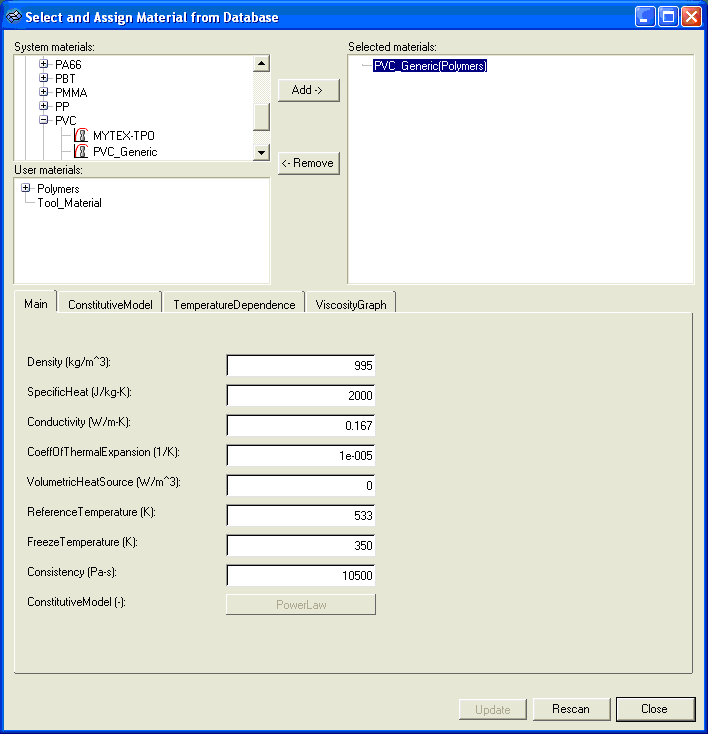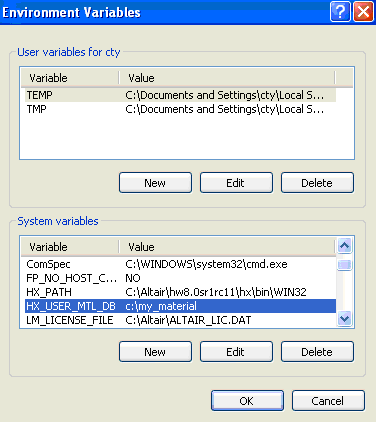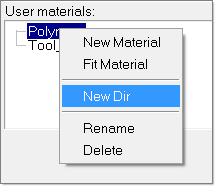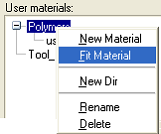In this tutorial, you will:
| • | Load the model into HyperMesh. |
| • | Assign the material to Polymer |
| • | Fit a new material based on viscosity data as a function of temperature and strain rate; and add it to the database |
This tutorial example explains the procedure to fit a new material into database.
The Material Data macro allows you to select an existing material from the database or create a user-defined material database based on the material properties of your choice.

The model files for this tutorial are located in the file mfs-1.zip in the subdirectory \hx\MetalExtrusion\HX_1404. See Accessing Model Files.
To work on this tutorial, it is recommended that you copy this folder to your local hard drive where you store your HyperXtrude data, for example, “C:\Users\HyperXtrude\” on a Windows machine. This will enable you to edit and modify these files without affecting the original data. In addition, it is best to keep the data on a local disk attached to the machine to improve the I/O performance of the software.
|
| 1. | Open the model HX-1404.hm. |
The HyperXtrude installation comes with a default set of materials for workpiece, tool, and polymers.
You can access these from the System Material section in the Material Data window. You can select from the list and add to the selected materials list and assign it to the relevant components.
| 3. | Expand Polymers, expand PVC and select PVC_Generic. |
| 4. | Click add to select the material for the Polymer components. |
| 5. | Right-click PVC_Generic in the Selected materials section to access the Assign Material option. |
| 6. | Assign the material to the Polymer components: Land3D, Manifold53D, Manifold43D, Manifold33D, Manifold23D, Manifold13D, Manifold03D and Profile3D by clicking All. |
| 7. | Click Update to assign the material. |
|
The user material section can be specified using the system environment variable:
Environment Variable
|
HX_USER_MTL_DB
|
Value
|
{user-defined path}
For example:
C:\my_material
|
Upon setting the environment variable, the user material section displays. This section allows you to create material data that is proprietary or point to existing material data.
| Note: | You can also set your own material database/path that co-exists with the default HyperXtrude material database in the installation. Once you have set the material environment variable, click rescan to refresh the Select and Assign Material from Database window. Quitting and re-starting HyperMesh can also activate the new database. |
The following is an example of the system setting on Windows XP:

|
| 1. | Right-click on Polymers in system/user materials. |
| 2. | Select New Dir. This refreshes the bottom half of the widget and prompts you to enter the name of the new directory. |

| 3. | Enter a directory name (such as user1) and click Create. |
A new sub-directory called user1 is created under Polymers.
| 4. | To change the name of a directory, right-click on it and select Rename. |
| 5. | To remove a directory, right-click on it and select Delete. |
|
| 1. | Expand the Polymers directory, then right-click Polymers. This displays options to add new directories or materials to the database. |
The new material can be added to system materials or user materials.
| 2. | Select Fit Material from the menu. |

This will prompt you to select a data file with viscosity as a function of strain rate and temperature. There are two samples in the tutorial folder and you can study them for the format.
| 3. | Browse and select the file hx-1404-sample.dat in the folder HX-1404. This will fit a material file based on the data in the file. |
| 4. | Once the data is created, it will prompt you to click OK to finish and inspect the material data. This new material will have the name specified in the first line of the file for the keyword Name. |

| 5. | Click Close to close the window. |
|
Return to Polymer Processing Tutorials








